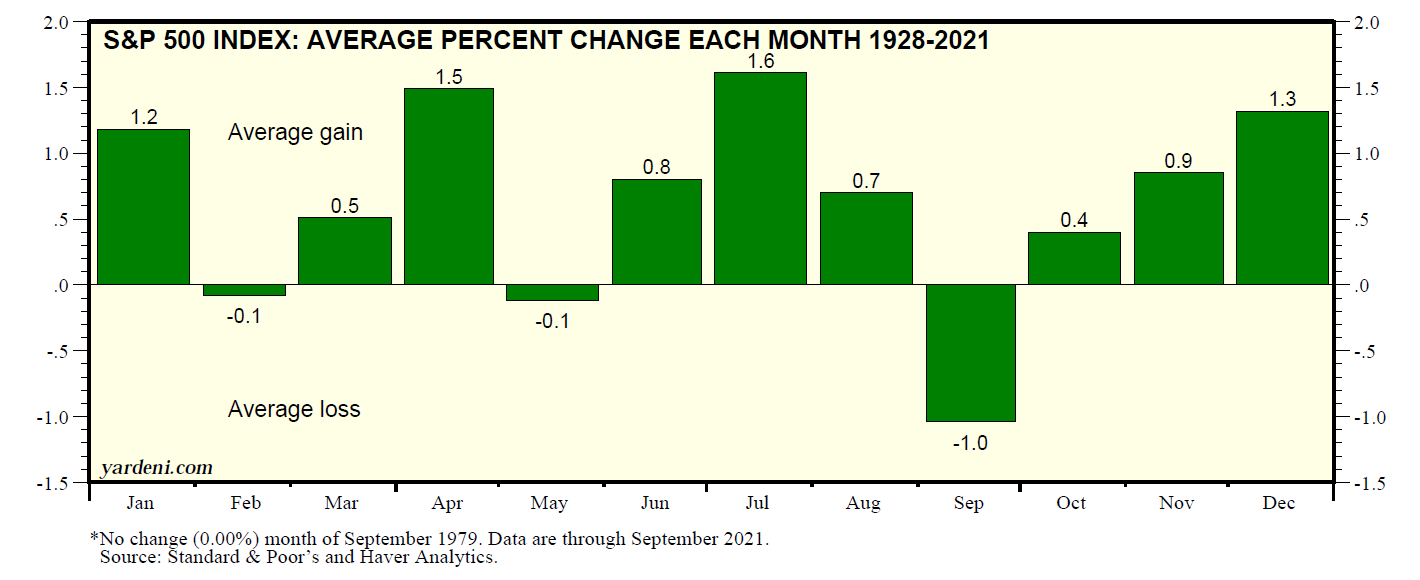
Frightened by the October Effect?
It’s that time of year. The leaves are changing colors. Halloween decorations are everywhere. October is the month we conjure up our worst fears – ghosts, goblins and stock market plunges.
Stock market plunges? Yes, plunges:
- Black Monday & Tuesday – October 28 & 29, 1929 the Dow Jones Industrial Average (DJIA) declined over 20% in two days starting the bear market leading to The Great Depression
- Black Monday – October 19, 1987 – the DJIA fell over 20%
- September 29 - October 2008 – the DJIA falls significantly throughout the month continuing its slide from September and leading into The Great Recession
October is notorious and in our collective psyche. Believe it or not, October is not on average the worst month in the market. That title goes to September (see chart below), and we’ve already had a rough September 2021. 
Source: October 5, 2021 Stock Market Indicators: Historical Monthly & Annual Returns (Yardeni Research, Inc.)
October is one of the more volatile months in the stock market. It is second only to March in average volatility as shown by the historical monthly averages on the VIX Index (see chart below).

Source: Cboe Global Markets/Options Institute (10.7.2021)
With September having the average worst monthly returns in the stock market and October being one of the more volatile months, it is not shocking that October often feels like a ‘rocky’ month for investors.
What causes the October Effect? Contributing factors could be the end of summer and the ‘return to school & work’ mentality, end of the third calendar quarter and anticipation of the last earnings season of the year, end of the U.S. fiscal year (September 30) and election cycles. All of which may lead to the expectation and then self-fulfillment of market volatility at this time of year.
On top of those annual issues, this year, we are facing the ‘debt ceiling’, ‘Facebook scandal’, ‘transitory’ inflation, rising interest rates as the Federal Reserve looks to taper its COVID-19 support of the bond market, political loggerheads and the continuation of the COVID-19 pandemic.
Any way you slice it, October seems to present increased uncertainty and markets react to uncertainty.
How do we deal with the Specters of Uncertainty? Face your fears.
First, despite our selective memory, October has not cornered the market on sharp declines and corrections. From 2010 to present, we have had 15 corrections of over 5% (ten were over 9%) (see chart below). Most of these did not occur in October. Recently, we had substantial stock market corrections in January and December of 2018, and we all remember that the COVID-19 bear market started in February and bottomed in March of 2020.

Source: October 5, 2021 Market Briefing:S&P 500 Bull & Bear Markets & Corrections (Yardeni Research, Inc.)
Bottom line – market corrections and bear markets can happen at any time. Instead of worrying about it in October, you need to be prepared any time of the year.
More specifically, in any given year, you should expect broad stock market declines of 5% about three times per year and 10% once a year. (See chart below.)
Market downturns happen frequently but don’t last forever.
Standard & Poor’s 500 Composite Index (1950-2019)
| Size of Decline | -5% or More | -10% or More | -15% or More | -20% or More |
| Average Frequency* | About 3 times per year | About once per year | About once every 4 years | About once every 6 years |
Average Length** |
43 Days | 112 Days | 262 Days | 401 Days |
*Assumes 50% recovery of lost value **Measures market high to market low
Source: Capital Group, Standard & Poor’s (10.8.21)
Even with this type of volatility, ‘time in the market is more important than timing the market’. As you can see from the BlackRock chart below, staying invested through volatility is critical to meeting your goals and a significantly better strategy than worrying about the market or trying to time it.

Source: BlackRock (Strategies for Volatile Markets 8.26.21)
So, How Do We Stay Invested?
We believe that the best way to stay invested and to meet your goals is to build your investment strategy through the financial planning process. A well-developed financial plan based on your personal needs (i.e., cash flow & taxes), risk capacity and investing time horizon, informs all of your investment decisions and will help you ride out market volatility.
Naturally, you need to focus on an appropriate asset allocation based on your personal goals and risk capacity to build your investment portfolio. We find that when the portfolio is tied back to a plan, clients are less likely to panic and make mistakes during market volatility. It is the combination of a well-thought out portfolio and actionable financial advice which counters the October Effect.
If October markets have you scared, it may be time to revisit your financial plan to confirm that your investment portfolio is invested to meet your specific needs, goals and risk capacity.

